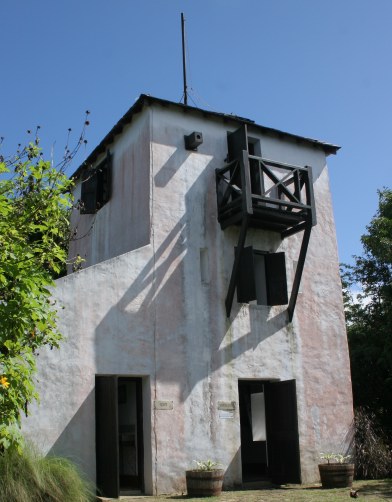Grenade Hall Signal Station provides fantastic views of the East Coast


Established before modern communications systems, they were relatively fast and efficient.
Messages sent from the North of the island would be relayed and reached Bridgetown in the South of the island within minutes.
What were they made of?
The walls and foundations were made of local coral blocks and rubble, including some bricks.
The walls were covered with cement and painted, they were usually 1 to 2 feet thick. The mast, floors, roof and doors were made of wood which could have been imported. The hardware, square nails and hinges were not localy made.
Why were they built?
It is believed that the original function of the stations was to alert the authorities of any sign of slave uprising. In 1816, Barbados witnessed its first slave rebellion.
This unexpected revolt was crushed only after a few days and much damage. Although only one militiaman died, several hundred slaves were either killed, executed or exiled and about a quarter of the sugar cane crop was burnt.
The fear instilled in the white population and particularly the plantocracy, prompted Lord Combermere, Governor of Barbados in 1817, to propose this means of communication. Within two years, a chain of six stations was functioning.
Did they serve other purposes?
Transmitting intelligence of potentual uprisings was not the only purpose behind the construction of Grenade Hall signal station. The sighting of ships seems to have also been a major concern in the selection of their location.
In fact, this was their major function from the early 1820's. Even if Bridgetown was a bustling harbour, the signalmen were probably not very busy and they were given added tasks.
Eventually they conveyed information to members of the Council about upcoming meetings, hoisted, time balls, to mark different hours of the day and possibley sent warnings of approaching hurricanes.
What means did they use to communicate?
Given the height of the masts,it is obvious that messages were sent by flags. These were of different shapes, colors and combination and the height at which they were hoisted was also significant.
As with Grenade Hall signal station, the top floor of the towers, usually had holes in the walls pointing toward the stations with which they were connected.
Therefore, signalmen did not need to scrutinize the horizon to find their position. If they communicated at night using light-signals, these holes would also have been most important.
A drawing dating from 1851 shows two pieces of wood attached to the mast of Grenade Hall signal station. Obviously, a faster system of signaling through semaphores was then in use. It was also more efficient on windless days.
Signals used at Highgate are illustrated in the Barbados Almanac of 1861. They could indicate the nationality, type and number of ships as well as their position.
The time was also given to the surrounding population through a device known as, time balls,.
The signals to be used in case of a slave uprising are unknown. Others, which could have been secret, have not survived in the archives.
In England at about the same time, a series of stations were used between Portsmouth and the Admiralty in London.
Signaling was done through flags and ,balls, as well as shutters and semaphores. There, the position of the semaphore arms represented the different letters of the alphabet.
What are Semaphores?
Semaphores are a device for conveying information by changing the position of a flag, light etc. At Grenade Hall signal station the wooden arms could be placed at right angle or diagonally,on the left or right side of the mast.
Were all the signal stations identical?
Grenade Hall signal station, Cotton Tower and Dover Fort which were built in 1819 to complete the chain of signal stations were essentially similar in plan: a square three-storied tower with or without an annex and sometimes a wooden kitchen a drawing of 1851 shows these features.
Gun Hill signal station, Moncrieffe and Highgate were older and much more complex buildings. Many more men were stationed there which required the construction of soldiers barracks, officers quarters, kitchens and other structures.
Were all signal stations on high ground?
No, but they were strategically placed to command an extensive view of the surrounding countryside and an open view of the ocean. Their elevation varies considerably but they do form a chain:
- Dover Fort, St.Peter - 100ft 30m
- Grenade Hall, St. Peter - 837ft 254m
- Cotton Tower, St. Joseph - 1091ft 331m
- Gun Hill, St. George - 728ft 221m
- Moncrieffe, St. Phillip - 564ft 171m
- Highgate, St. Michael - 259ft 78m
The highest point in Barbados, Mt Hillaby, is at 1115 feet (338 meters).
Admission to Grenade Hall signal station is included in the price of the entry ticket to the Barbados wildlife reserve
Return from Grenade Hall Signal Station to Barbados Wildlife Reserve
Return from Grenade Hall Signal Station to Best Barbados Beaches


